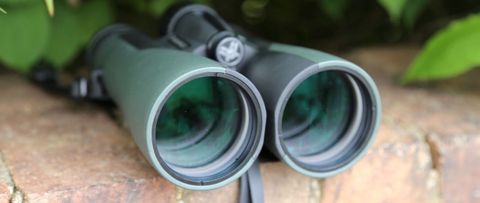f you can't decide between buying binoculars primarily for wildlife or astronomy then you only have one decision to make. Perfect for both day and night activities, 10x42 or 10x50 binoculars are the best option for most people, though the Vortex Crossfire HD 10x50 we have here is a definite step-up product that comes with a unique chest harness for extra comfort and quick deployment. Here’s everything you need to know about the Vortex Crossfire HD 10x50 binoculars and why we think they’ll have a wide appeal.
Vortex Crossfire HD 10x50 specifications

Magnification: 10x
Objective diameter: 50mm
Field of view at 1000m: 107 metres
Closest focusing distance: 1.83m/6 feet
Eye relief: 17mm/0.67”
Weight: 862g/30.4 oz
Dimensions: 17 x 13.4 cm/6.7 x 5.3 inches
Key features

The Crossfire HD boasts 10x magnification and has 50mm objective lenses, with a reasonably wide 6° field of view. They use the roof prism optical design, which keeps them compact. Essentially two aluminum tubes joined by a hinge that supports the focusing knob, the glass prisms inside the Crossfire HD use BaK-4 glass to minimize reflections. The HD refers to the glass used inside those tubes, primarily to reduce any colour fringing (also called chromatic aberration), but also to increase both sharpness and contrast in images.
Build & handling

Hold the Crossfire HD binoculars in your hand and they have a very solid feel. Their green and black covering is rubbery, though not as textured as usually found on binoculars of this kind. No matter because the Crossfire HD’s design incorporates a couple of indents for placing your thumbs while holding them.
However, the most unusual thing about the crossfire HD isn't the design of the binoculars themselves, but the provision of a chest harness. Not typically found in the box of any other pair of binoculars we know of, it's a relatively basic and lightweight harness, but nevertheless works really well when using the Crossfire HD for long periods. Instead of having a basic neck strap attached to each side of the binoculars, the Crossfire HD has two small lengths of cord with a clip on each end. They then clip into the chest harness.
One thing we definitely did not like about using these binoculars were its lens caps, which are attached by short plastic cords to the hinge. Sure, that prevents them from getting lost, but it also means they swingl about uncontrollably while binoculars are being used.
Performance

Although we love the idea of a chest harness, the one supplied with the Crossfire HD is not as versatile as it could be. Although it's a great option to have, the binoculars clip into Vortex’ GlassPak binocular harness. Sadly it’s impossible to wear the harness without also wearing the bag (which we should more accurately call the ‘harness bag’) since it’s an integral part of the harness. As well as not being able to remove the bag from the harness, the clips attached to the binoculars cannot also be used with the separate neck strap supplied, which has to be manually fastened to the binoculars. It all seems like a couple of missed opportunities for what could be a seriously impressive design.
Optically speaking, the Crossfire HD binoculars are hugely impressive, balancing brightness and sharpness to get great results for a variety of scenarios. We took them along to a football match and enjoyed the slightly larger than average field of view of about 5°, also noticing that they were sharp almost completely across the entire field of view. In low light, and no light, the Crossfire HD also impressed, with lots of sharpness and contrast; we pointed them at the Pleiades star cluster and the Moon, the former of which had plenty of brightness and contrast while the latter was particularly clean and detailed.
Verdict

With an excellent build quality and superb optics, we think the Vortex Crossfire HD 10x50 should be candidate binoculars for anyone looking for a step-up option to use for many years in all kinds of scenarios, from wildlife to sport to astronomy. The things we didn't like about the Crossfire HD include the chest harness’ lack of versatility and a poor design for the objective lens caps, but these are mere details within an extremely impressive package.
Read more:
• The best binoculars
• Best budget binoculars under $100
• Best marine binoculars
• Best rangefinder binoculars
• Best compact binoculars
• Best opera glasses
• Best binocular harnesses
• Best binocular tripod adapter
• The 10 best spotting scopes
• The best night vision goggles
• The best opera glasses
• The best telescopes for astrophotography



